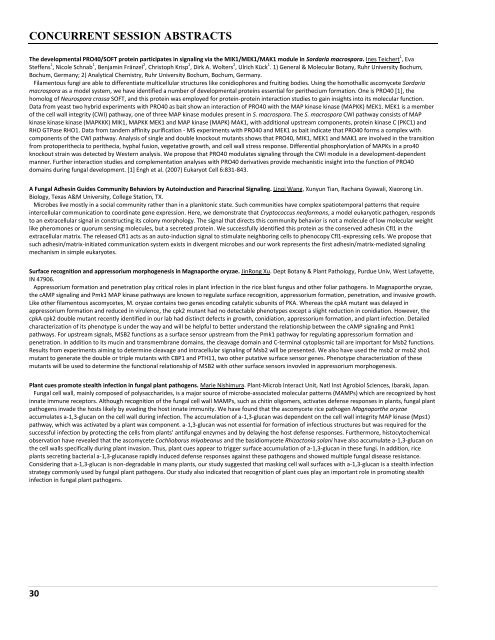Program Book - 27th Fungal Genetics Conference
Program Book - 27th Fungal Genetics Conference
Program Book - 27th Fungal Genetics Conference
Create successful ePaper yourself
Turn your PDF publications into a flip-book with our unique Google optimized e-Paper software.
CONCURRENT SESSION ABSTRACTSThe developmental PRO40/SOFT protein participates in signaling via the MIK1/MEK1/MAK1 module in Sordaria macrospora. Ines Teichert 1 , EvaSteffens 1 , Nicole Schnab 1 , Benjamin Fränzel 2 , Christoph Krisp 2 , Dirk A. Wolters 2 , Ulrich Kück 1 . 1) General & Molecular Botany, Ruhr University Bochum,Bochum, Germany; 2) Analytical Chemistry, Ruhr University Bochum, Bochum, Germany.Filamentous fungi are able to differentiate multicellular structures like conidiophores and fruiting bodies. Using the homothallic ascomycete Sordariamacrospora as a model system, we have identified a number of developmental proteins essential for perithecium formation. One is PRO40 [1], thehomolog of Neurospora crassa SOFT, and this protein was employed for protein-protein interaction studies to gain insights into its molecular function.Data from yeast two hybrid experiments with PRO40 as bait show an interaction of PRO40 with the MAP kinase kinase (MAPKK) MEK1. MEK1 is a memberof the cell wall integrity (CWI) pathway, one of three MAP kinase modules present in S. macrospora. The S. macrospora CWI pathway consists of MAPkinase kinase kinase (MAPKKK) MIK1, MAPKK MEK1 and MAP kinase (MAPK) MAK1, with additional upstream components, protein kinase C (PKC1) andRHO GTPase RHO1. Data from tandem affinity purification - MS experiments with PRO40 and MEK1 as bait indicate that PRO40 forms a complex withcomponents of the CWI pathway. Analysis of single and double knockout mutants shows that PRO40, MIK1, MEK1 and MAK1 are involved in the transitionfrom protoperithecia to perithecia, hyphal fusion, vegetative growth, and cell wall stress response. Differential phosphorylation of MAPKs in a pro40knockout strain was detected by Western analysis. We propose that PRO40 modulates signaling through the CWI module in a development-dependentmanner. Further interaction studies and complementation analyses with PRO40 derivatives provide mechanistic insight into the function of PRO40domains during fungal development. [1] Engh et al. (2007) Eukaryot Cell 6:831-843.A <strong>Fungal</strong> Adhesin Guides Community Behaviors by Autoinduction and Paracrinal Signaling. Linqi Wang, Xunyun Tian, Rachana Gyawali, Xiaorong Lin.Biology, Texas A&M University, College Station, TX.Microbes live mostly in a social community rather than in a planktonic state. Such communities have complex spatiotemporal patterns that requireintercellular communication to coordinate gene expression. Here, we demonstrate that Cryptococcus neoformans, a model eukaryotic pathogen, respondsto an extracellular signal in constructing its colony morphology. The signal that directs this community behavior is not a molecule of low molecular weightlike pheromones or quorum sensing molecules, but a secreted protein. We successfully identified this protein as the conserved adhesin Cfl1 in theextracellular matrix. The released Cfl1 acts as an auto-induction signal to stimulate neighboring cells to phenocopy Cfl1-expressing cells. We propose thatsuch adhesin/matrix-initiated communication system exists in divergent microbes and our work represents the first adhesin/matrix-mediated signalingmechanism in simple eukaryotes.Surface recognition and appressorium morphogenesis in Magnaporthe oryzae. JinRong Xu. Dept Botany & Plant Pathology, Purdue Univ, West Lafayette,IN 47906.Appressorium formation and penetration play critical roles in plant infection in the rice blast fungus and other foliar pathogens. In Magnaporthe oryzae,the cAMP signaling and Pmk1 MAP kinase pathways are known to regulate surface recognition, appressorium formation, penetration, and invasive growth.Like other filamentous ascomycetes, M. oryzae contains two genes encoding catalytic subunits of PKA. Whereas the cpkA mutant was delayed inappressorium formation and reduced in virulence, the cpk2 mutant had no detectable phenotypes except a slight reduction in conidiation. However, thecpkA cpk2 double mutant recently identified in our lab had distinct defects in growth, conidiation, appressorium formation, and plant infection. Detailedcharacterization of its phenotype is under the way and will be helpful to better understand the relationship between the cAMP signaling and Pmk1pathways. For upstream signals, MSB2 functions as a surface sensor upstream from the Pmk1 pathway for regulating appressorium formation andpenetration. In addition to its mucin and transmembrane domains, the cleavage domain and C-terminal cytoplasmic tail are important for Msb2 functions.Results from experiments aiming to determine cleavage and intracellular signaling of Msb2 will be presented. We also have used the msb2 or msb2 sho1mutant to generate the double or triple mutants with CBP1 and PTH11, two other putative surface sensor genes. Phenotype characterization of thesemutants will be used to determine the functional relationship of MSB2 with other surface sensors invovled in appressorium morphogenesis.Plant cues promote stealth infection in fungal plant pathogens. Marie Nishimura. Plant-Microb Interact Unit, Natl Inst Agrobiol Sciences, Ibaraki, Japan.<strong>Fungal</strong> cell wall, mainly composed of polysaccharides, is a major source of microbe-associated molecular patterns (MAMPs) which are recognized by hostinnate immune receptors. Although recognition of the fungal cell wall MAMPs, such as chitin oligomers, activates defense responses in plants, fungal plantpathogens invade the hosts likely by evading the host innate immunity. We have found that the ascomycete rice pathogen Magnaporthe oryzaeaccumulates a-1,3-glucan on the cell wall during infection. The accumulation of a-1,3-glucan was dependent on the cell wall integrity MAP kinase (Mps1)pathway, which was activated by a plant wax component. a-1,3-glucan was not essential for formation of infectious structures but was required for thesuccessful infection by protecting the cells from plants’ antifungal enzymes and by delaying the host defense responses. Furthermore, histocytochemicalobservation have revealed that the ascomycete Cochlioborus miyabeanus and the basidiomycete Rhizoctonia solani have also accumulate a-1,3-glucan onthe cell walls specifically during plant invasion. Thus, plant cues appear to trigger surface accumulation of a-1,3-glucan in these fungi. In addition, riceplants secreting bacterial a-1,3-glucanase rapidly induced defense responses against these pathogens and showed multiple fungal disease resistance.Considering that a-1,3-glucan is non-degradable in many plants, our study suggested that masking cell wall surfaces with a-1,3-glucan is a stealth infectionstrategy commonly used by fungal plant pathogens. Our study also indicated that recognition of plant cues play an important role in promoting stealthinfection in fungal plant pathogens.30











